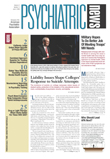In both men and women, psychiatric disorders in late adolescence appear to predict involvement in clinically significant partner abuse during early adulthood, according to a report in the May American Journal of Psychiatry.
Longitudinal study of a birth cohort found that both men and women who became involved in clinical partner abuse between the ages of 24 and 26 had significantly higher rates of certain psychiatric disorders at age 18 than those who did not become involved in partner abuse.
Among women, those disorders included major depressive disorders and marijuana abuse; among men, they included major depressive episodes, marijuana dependence, alcohol dependence, and any anxiety disorder, according to the study.
The study also found that partner abuse predicts an increase in psychiatric disorders— especially depression, marijuana dependence, and posttraumatic stress disorder—but only for women. For men, mental disorders following partner abuse appear to reflect their history of mental disorder in adolescence.
“This is the first time, to our knowledge, that a study has been able to untangle the temporal link between partner violence and mental disorder, by looking at changes within individuals over time,” said lead author Miriam K. Ehrensaft, PhD. “That is, we measured psychiatric disorders before and after the abuse. Other studies have measured both at the same time, making it hard to determine which came first.”
She is with the Division of Child Psychiatry at Columbia University College of Physicians and Surgeons.
Ehrensaft told Psychiatric News that the differential finding regarding the aftereffects of partner abuse for men and women is evidence of real gender differences in the mental health effects of partner abuse, particularly among women of child-bearing age.
“What's important is that this gender difference in mental health effects emerged even though both men and women in our partner abuse group said they had been victimized by their partner at the same high rates,” Ehrensaft said.
In the study, a cohort from the Dunedin Multidisciplinary Health and Development Study was followed prospectively. Adolescent mental health disorders were diagnosed at age 18. The researchers then identified individuals involved in nonabusive relationships versus those who were involved in clinically abusive relationships between the ages of 24 and 26. (A clinically abusive relationship was defined as resulting in injury and/or official intervention.) Finally, mental disorders were assessed again at age 26.
The results showed that both men and women with mental disorders in adolescence were at greater risk of becoming involved in abusive adult relationships. But when the researchers controlled for earlier psychiatric disorder, only women experienced an increased risk for psychiatric morbidity after partner abuse.
Ehrensaft said she believes psychiatrists should routinely include a few questions about current or recent partner abuse in evaluations of young women. Such questions could ask about specific acts, such as hitting, kicking, or pushing, and about consequences, including injuries or legal intervention.
“Partner abuse may be an important part of the etiology of a woman's presenting problem and is usually not spontaneously disclosed,” Ehrensaft told Psychiatric News.
She said clinicians should familiarize themselves with available local resources and be prepared to refer patients. “Our findings highlight the importance of integrating partner violence into psychiatric research and clinical training,” she said.
